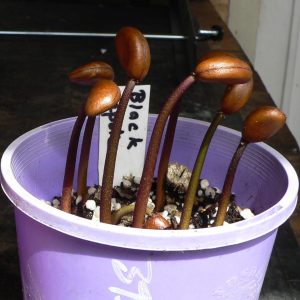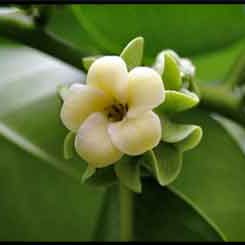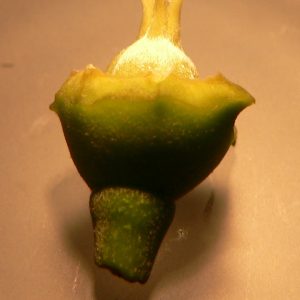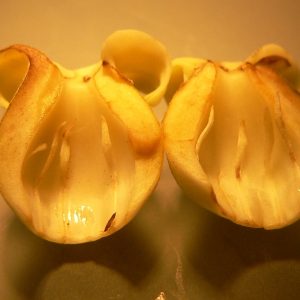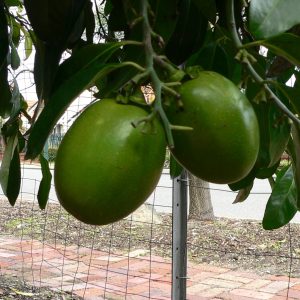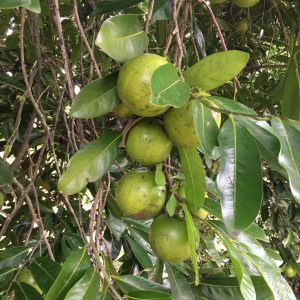Diospyros nigra (digyna)
Black sapote, black persimmon, chocolate pudding fruit
Origin
Native to the lowlands of Central America and Mexico.
Climate
It is a sub-tropical/tropical tree that grows at altitudes up to 2000m in the tropics, favouring moist conditions and can even tolerate sporadic flooding. It is sensitive to drought. Mature trees can withstand light frosts but young plants need protection.
Plant Description
A handsome, slow-growing, perennial evergreen tree with a broad canopy, 6-9m tall, but can be much larger in favoured environments. The alternate leaves are simple, glossy dark green, leathery and elliptic-oblong, 10-25cm long.
Relatives
Ebenaceae family with about 500 species in the genus Diospyros. Closely related to persimmon and mabolo but not to white, green, yellow or mamey sapote.
Soils
This is an undemanding species. While it does best in a light deep soil rich in organic matter it will also grow in sandy or calcareous and alkaline soils, usually without major micronutrient deficiencies.
Propagation
Seeds are usually used; these will germinate in about 30 days and if properly dried remain viable for several months. Seedlings grow slowly at first, they do not come true to type and may take 4-5 years to begin fruiting. Grafting and budding is preferred, usually onto seedling rootstocks.
Cultivars
There are only a few named cultivars, including Tahiti, Bernecker (seedless), Mossman, Maher, Reineke and Manilla.
Most of these are difficult to source in WA.
Flowering and Pollination
Black sapote is usually dioecious. Less commonly it is structurally but not functionally hermaphroditic with rudimentary staminodes and pistillodes, & less frequently monoecious or polygamous (leaky dioecy). Inflorescences are axillary cymes, and males typically have more flowers (3-6) than females (1-2). Flowers have white petals with a persistent 4-5-lobed green calyx. Males usually have many stamens (4-20) and a much reduced non-functional ovary, whereas in females the superior ovary is well developed with 8-12 carpels and stamens are reduced to a few (4-8) staminodes. Named cultivars are commonly female, and the presence of male or monoecious types is usually required for good pollination and fruit set, with insects being the main vectors. Some self-incompatibility has been reported in monoecious plants.
Cultivation
They should be planted in full sun for best fruit production. It is not demanding in fertilizer requirements. When young, small and frequent applications of NPK rather than infrequent larger amounts can be given to hasten growth. Total yearly amounts should be increased as the tree grows. Any micronutrient deficiencies that do occur can be rectified by foliar sprays. Over-fertilizing is contraindicated for yield. Young plants need regular watering but mature trees are often more self-sufficient unless there is a prolonged dry period. As always, mulch is beneficial.
Wind Tolerance
They need protection from strong winds. Maintenance at a size convenient for harvesting and spraying also assists.
Pruning
When young, formative pruning should be undertaken to develop a spreading canopy permitting light penetration throughout the tree. Size containment will probably be necessary when older.
The Fruit
The fruit is an oblate climacteric berry, 5-10cm wide, with a prominent undulate green calyx, occurring singly or in clusters. Skin is a shiny bright green colour. As the fruit matures over 4-5 months, the calyx ends rise slightly from the fruit and the shiny skin loses some lustre. It can be picked at this stage and will ripen in 7-14 days (often miraculously overnight) at room temperature, the skin turning to a dull olive-green and the fruit becoming very soft. When ripe, the flesh is dark brown to almost black and may enclose 0-12 brown seeds. It has good levels of Ca, vitamin C and antioxidant activity with carbohydrate content of 13-16%. Unripe fruit are very astringent.
Fruit Production and Harvesting
Seedling trees may take 4-6 years to fruit, and harvesting is usually autumn-late winter. Mature but not ripe fruit should be cut rather than pulled from the tree. Do not try to tree-ripen fruit as they are soft and will self-destruct if allowed to drop. Green mature fruit stored at less than 10°C will likely suffer chilling injury. When ripe, fruit last only a few days and slightly longer in a crisper.
Fruit Uses
The fruit can be eaten by spooning out the flesh; a sprinkle of lemon juice may improve flavour. The most common use is to flavour ice-cream, milk shakes, cakes, mousse etc. Pulp or whole fruits can be frozen.
Pests and Diseases
Scale insects may need to be dealt with but trees are generally free of problems.
Comments
Black sapote can be a large tree if not managed, but can produce copious quantities of fruit. The taste doesn’t appeal to everyone but can be improved with additions or processing. Visually, its general attraction as a fruit crop is handicapped by a non-flashy skin colour and the unusual dark brown flesh.
